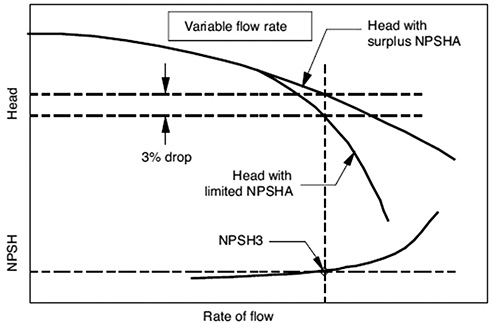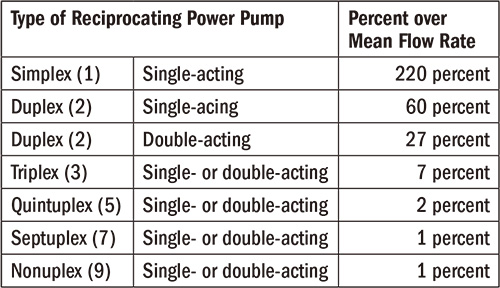Q. What is NPSH3, and how does it relate to the NPSHR for a rotodynamic pump? A. The Hydraulic Institute defines the required net positive suction head (NPSHR) of a pump as the net positive suction head available (NPSHA) that will cause the total head (first-stage head of multistage pumps) to be reduced by 3 percent because of flow blockage from cavitation vapor between the impeller vanes. The NPSHR qualified by this criterion is referred to as NPSH3. The full published pump head will not, however, be achieved (by definition) when the NPSHA equals the NPSH3 of the pump (see Figure 9.6.1.1b). The value of a 3-percent head drop for NPSH3 is based on accepted industry practice for defining a condition of head breakdown because of cavitation.
 Figure 9.6.1.1b. NPSH3 determination for variable flow rate test
Figure 9.6.1.1b. NPSH3 determination for variable flow rate test- Install a booster as close as practical to the inlet source.
- The booster pump must add enough pressure to the system to provide sufficient NPSHA to the power pump, allowing for acceleration head, friction losses and pressure pulsations because of acoustical resonances.
- Install a pulsation dampener in the inlet line adjacent to the power pump liquid cylinder. Consult dampener and pump manufacturers for the proper location. The dampener can often be omitted between a centrifugal booster pump and a low-speed power pump under any of the following conditions:
- The diameters of the inlet and outlet connections of a booster are equal to or larger than the inlet connection of the power pump.
- The diameters of all the piping between the liquid source and power pump are equal to or larger than the inlet connection of the power pump.
- The booster pump is sized for the maximum instantaneous flow rate of the power pump.
- Acceleration head is calculated not only between the booster and power pump but also between the liquid source and the booster.
- If the booster pump is a constant-speed, positive-displacement pump, a self-regulating bypass valve is required between the pumps. The booster pump must be sufficiently oversized to provide the minimum flow required through the bypass valve.
 Table 1. The percentage that the maximum instantaneous flow rate exceeds the mean flow rate
Table 1. The percentage that the maximum instantaneous flow rate exceeds the mean flow rate
